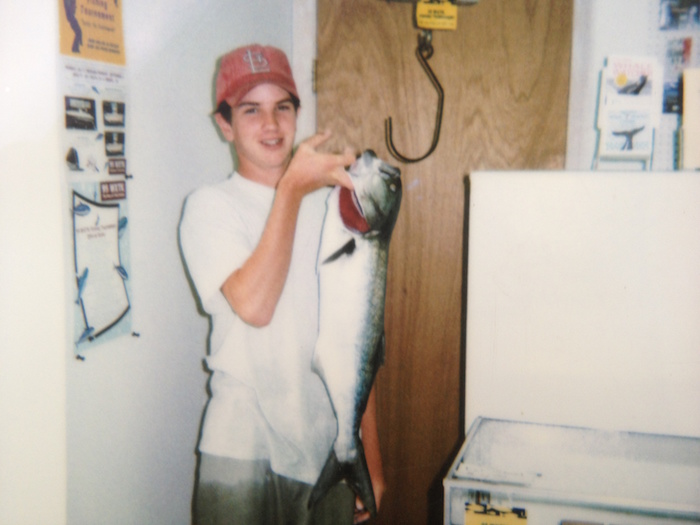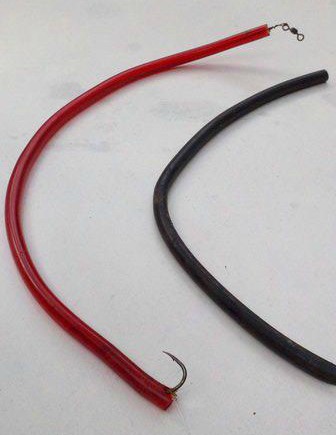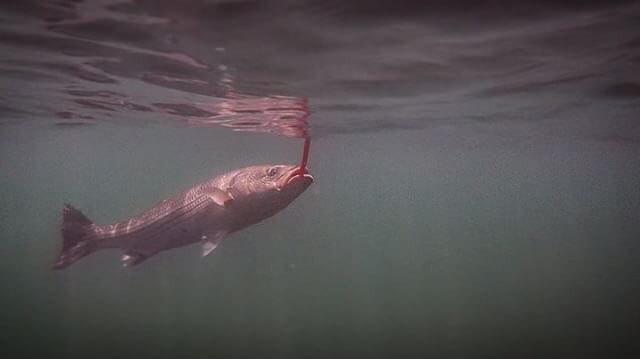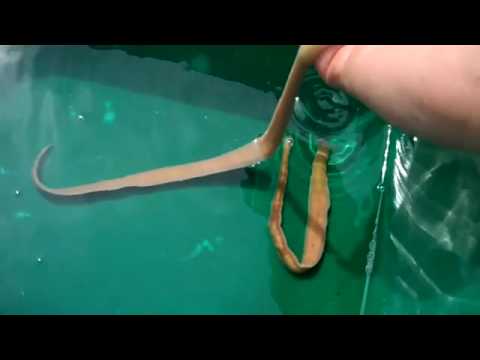There was a lot of cigarette smoke swirling around the bait shop as I carefully twisted 220 pound wire around a black swivel. Bob, one of the regulars, had been telling fish stories about the good old days at Nauset beach, while simultaneously puffing his cigarette.
I didn’t mind the smoke though. I was a 14 year old fisherman, eager to put big bass in the boat, and I could certainly use any tidbit of information I could get. I sat there quietly at the table, breathed in the second hand smoke, and continued rigging up red and orange tubes
“I guess the bass are stacked like cordwood on Scorton Ledge,” muttered Bob, in his signature scratchy voice.
“That explains why the tubes have been flying off the shelves,” chimed in Jim, the co-owner of One Shot Bait and Tackle, a small shop that used to be located by the Sagamore Bridge.

I started working at One Shot Outdoor Sports in Sagamore when I was around the age of 14. The shop is no longer in existence, but I learned a lot during those years to say the least!
Hearing the news about fish stacked up on the Ledge made me more eager than ever to get out of the shop. I still had to rig up two dozen more tubes and count six flats of sandworms before I had any chance of getting on the water. So I did the only thing I could do, and picked up the pace.
I was nearly finished with the day’s quota of tubes when a gentleman walked into the shop dragging a massive fish. The bass was a monster, and pulled the shop’s scale to 42 pounds. I did not know the angler who caught it, although I remembered him purchasing a tube and a dozen worms earlier that morning.
“The stripers are everywhere,” he said. “I’ll let you in on the trick. The fish are only hitting 24 inch long red tubes, but don’t tell anyone.”
The man spoke as if he had discovered some top secret technique. He did not realize that we had been weighing big fish all weekend, and that each jumbo bass had been caught on a 24 inch long red tube. Jim, Bob and I kept our mouths shut, and let the fisherman have his 15 minutes.

When I was younger I almost exclusively used 24 inch red tubes during the day (occasionally I would also use 30 inch orange tubes ). However, in recent years I feel I've gotten more bites using 20 inch red tubes than 24 inch, but I haven't kept any stats so I can't scientifically say they are more effective.
Throughout all of this I had not stopped working, and only had a handful of tubes to go before I could move onto the six flats of worms. I was chomping at the bit and the end of my shift was near. But as soon as the man turned and looked in my direction my heart sank. I knew what he was going to ask.
“Oh son, while you're at it, I’ll take six more red ones. I lost my fair share to those damn lobster pots.”
I handed the man a half dozen of the newly rigged red 24 inchers. Thanks to the lobster pots I was now an additional six more tubes away from getting home, and out to the fish.
The fisherman took the tubes and made his way to the register. Jim sold him another couple dozen sandworms, a spool of lead core and some sunscreen. The man took his bag of goodies, grabbed his forty pound bass by the gills and made his way to the door.
But before he left the fisherman turned around, and with a puzzled look on his face asked, “What in the hell do you think these damn tubes imitate?”
I looked over at Jim, who looked over at Bob, who then took a deep suck of nicotine before answering-“I have no idea.”
“Well who cares, they sure do catch fish!” said the man. He turned again, walked to his truck and drove away.
“Nice answer Bob,” said Jim in a sarcastic tone.
The Age Old Question

What does the tube and worm imitate? This question has been asked by countless anglers.
For the past decade I have wrestled with the same question posed by the fisherman that day at the bait shop. What does the tube and worm imitate? I figured that if I only knew for sure what type of animal the tube mimicked, then I could somehow use that information to become a better fisherman. Unfortunately, I have spent the greater part of my fishing career without any definitive answers.
The theories I have heard are all very interesting, and some are almost comical. Many anglers claim that bass think the tube is a giant eel. Even more creative are theories that include an eel swimming backwards with a sandworm in its mouth. I wonder how often striped bass come across this scenario in the natural world.
Others claim bass mistake the tube for a sandworm. Yet few anglers have ever seen a sandworm comparable to the size of many of today’s tubes. Most sandworms encountered by fishermen are a foot or less in length. Maybe a bass mistakes an 18 inch long tube for a sandworm, but what about the bass that are taken on goliath size tubes?
When I was in my teens and early twenties I did a lot of tube and worm trolling, and on many trips, only one color tube would catch fish. On other trips, one specific red tube would produce bass, while all the other red tubes in the boat caught nothing. Sometimes an 18 inch long tube worked, and other days a 30 inch long tube is all the bass would take.
“What in the world is going on?” I thought to myself on an almost daily basis.
Finally, I discovered evidence that may provide some answers. It took some research, but I now feel like I have a better grasp of what striped bass mistake the tube and worm for.
I also believe that striper addicts, like myself, can become more adept tube and worm anglers by understanding the very animal our tubes may be mimicking.
Do Bass Mistake Tubes for Large Worms?
One day while searching You Tube, I stumbled across a video that featured two worms squirming around in a tidal pool. The worms were big, and like nothing I had ever seen in my years of fishing and beach combing.
After some digging around I managed to get in contact with Tim Sheehan, a marine biologist and the producer of the You Tube clip. Sheehan owns Gulf of Maine Inc., which supplies hundreds of live marine creatures to people throughout the country for study and research purposes. To say Sheehan spends a bit of time combing the beach would be a severe understatement.
Milky Ribbon Worms
According to Sheehan, the worms in his You Tube video are called milky ribbon worms. To my astonishment, Sheehan claimed the worms could grow to be four feet in length! These long and fragile worms are found in the same sandy mud where bloodworms and sandworms lurk.
I immediately dove into researching these often times enormous ribbon worms. I did not find a plethora of information about the worm; however what I did find proved very interesting.
According to enature.com, milky ribbons range from Maine all the way down to Florida. They burrow in sand and mud and also like to hide under boulders and rocks. They can grow to be four feet long and 5/8 of an inch wide. They can be white, yellowish, pink or brown with mature males being red.
The pieces to the puzzle were starting to fall into place. According to enature.com, red and pink worms do exist in the wild. Based on Sheehan’s You Tube video, orange milky ribbons exist too. Not only do they exist, but they can grow to be four feet in length, which easily covers the range of tubes used by most striped bass fishermen. The 5/8 of an inch width of an average milky ribbon worm, also matched the 5/8 inch tubing I had been fishing with for the past decade.
Enormous Sandworms
After speaking with Sheehan about milky ribbon worms, the conversation shifted towards enormous sandworms. Sheehan made an important point that the sandworms that most fishermen use for bait all come from heavily fished tidal flats. Yet the sandworms’ habitat stretches out to depths of 200 feet. These depths are well beyond the reach of a worm digger, but well within the range of striped bass.
According to the biologist, worms out of the reach of diggers could grow to substantial sizes, well around the three foot mark. A sandworm three feet in length would be, according to Sheehan, “as thick as your thumb.” The orange, red and green coloration of sandworms also gives validity to the argument that enormous sandworms are indeed what striped bass believe they are chomping down upon when biting a tube.

Did you know the seaworms you may have purchased at bait shops can grow to be 3 feet in length and as thick as your thumb?
According to Sheehan, both female and male sandworms do a lot of swimming, and are quite mobile in the water compared to your average worm. However the worms’ motion through the water is more of a side to side wiggle than a spiraling tube. Yet when viewing a tube from above or below, one can understand how easy it may be for a fish to mistake the spiraling action of the tube for the side to side wiggle of a sandworm.
Milky ribbon worms and large sandworms resemble tubes in length, color, width and action.
Please
login or join MFCC to access
The rest of this post is only available to members of My Fishing Cape Cod.



Ryan, great article and very informative, thank you. The largest striper the Mrs. and I ever caught was a 45″ near Mashnee Island, trolling a red tube with the head of a squid on the hook, we had no worms. I’m now thinking, based on your findings, that the tentacles were similar to worms swimming. Maybe??
That’s a nice fish John! And perhaps the squid was similar to worms swimming, but if you take a look at Carl’s comment below, then you’ll see that Carl and his friends would often tip the hook of the tube with sand eels, strips of mackerel, and other baits, and they caught plenty of fish. Go figure!
Ryan in life we learn all sorts of interesting facts about fishing if we keep an open mind when we do it. The above post goes to show that the fishing experience only gets better the more you understand what and how you fish. The size of the tube at times can also determine the size of the fish , which for me has been shown to be true.
Red is the color most fish identify with for various reasons and even variations of red have been known to be more productive during the day or even night time trolling using this method to put fish in the box. One known item of interest is that when you place a worm on the hook by its head and let out the line it begins to gain length , to a point, if you bring it back after a few minute troll , may be twice the size in length then when you began. How you place the hook through the head of the worm you use also determine in some cases how many hits you get on that one worm before the fish hooks itself in many cases, to bend over your rod.
The same is true when you use just sea worms from the beach as well. Tube and worm over the years has been an affective way to catch striped bass form a boat , but i will also say that small eels alive or dead will work the same way . Strips of Mackerel , That have been cut uniformly and salted or even live ones placed on the hook will also work effectively as well.
Sand eels are another bait alive or dead that will also take striped bass. One needs to be prepared to change up what you place on the hook and be ready to give them something different and how you present the tube and what ever you place on the hook is a critical step in that process. Using the marked line also allows you to place the bait just enough above them or where they are swimming in search of food is paramount to how successful you get.
Some times with a 20 foot leader you can be into fish with only one color out on the tip of the rod and some times it may take more. That is why when you first start out to set the rods you are using at different levels. until you see at what depth they want what you are dragging. and what color or even what you have on the hook. Slow slow the boat is moving and your tube should be turning a slow roll beside the boat prior to dropping it to where you will start your fishing at. If the tube does not twist and roll then one needs to do a little bending to the wire inside the tube, unless you have mono then at times what you have for weight [Egg weight] up front may be the determining factor.
Also one needs to have a safety line attached to the rod with the drag set so when the bass hits the bait and gets hooked it will give a little , but not allow the reel to be stripped. One can always dream a little about the size of the fish you catch , but what you are fishing for [Striped bass] can result in other species getting caught as well. Blue fish love them , as do sand sharks, tuna fish, sea bass, Pollock, Cod as well .
Thems were other times when we had more of the other species around than today , but just for edification purposes it is different when you catch something you are not fishing for, it sort of brings a little comfort knowing you might have found another way to bringfish to the boat that you neer thought was possible. Peace and Prayers
Well said Carl, thank you. It can certainly pay to experiment and I am intrigued by your mention of placing sand eels, strips of mackerel, and other baits on the hook of the tube. That could be a fun experiment to do sometime. Thanks for the insight as always!